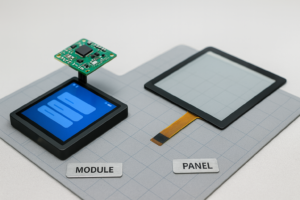Touchscreen technology has transformed how we interact with electronic devices. This technology, which eliminates the need for traditional input methods like keyboards and mice, has rapidly become indispensable in various sectors, including marketing, education, healthcare, entertainment, and beyond. This article explores the development of touchscreen technology, its advantages, and the promising future ahead.
Key Benefits of Touchscreen Technology
1. Intuitive for All Users
One of the most significant advantages of touchscreen technology is its intuitive nature. Almost everyone, regardless of age, is familiar with smartphones and tablets. For those unfamiliar with touchscreens, the learning curve is relatively flat, and it doesn’t take long to understand how to navigate the technology.
Touchscreen interfaces allow users to directly interact with the display, making it much simpler to access information. Features like on-screen keyboards make searching and typing even more efficient, enhancing the user experience.
2. Space-Saving and Convenient
Touchscreens replace the need for bulky physical controls like keyboards, buttons, and mice. These devices are sleek and slim, making them easy to integrate into any environment, whether for public kiosks or personal use. Unlike older systems with large directories or controls, modern touchscreens are compact and space-efficient.
The absence of physical input devices also makes touch devices portable and easier to manage. Whether it’s a kiosk, a POS terminal, or a home appliance, the use of touch interfaces simplifies the design and improves usability.
3. Ease of Maintenance
Touchscreens are relatively easy to clean and maintain. The absence of physical buttons and other components like mice means there are fewer areas for dust and grime to accumulate. Regular cleaning typically involves wiping down the smooth surface, which is much easier than cleaning devices with numerous buttons and moving parts.
This convenience is especially beneficial in environments where hygiene is critical, such as hospitals, restaurants, and public transportation.
4. Durability and Longevity
Traditional input devices, such as keyboards and mice, tend to wear out over time due to repeated use. Buttons can get stuck, and circuits can malfunction, reducing the overall lifespan of the device.
In contrast, touchscreens have fewer moving parts, which contributes to their durability. The lack of physical buttons reduces the risk of damage, making them more resilient and long-lasting. This durability is especially advantageous in industrial or outdoor applications where harsh conditions might otherwise compromise the functionality of other devices.
5. Replaces Traditional Input Devices
Touchscreen technology has rendered traditional input devices such as the mouse and keyboard largely redundant. Touchscreens allow users to interact directly with the interface by simply tapping, swiping, or scrolling.
This streamlining of input devices not only makes for a cleaner, more modern design but also simplifies the learning process for new users. The touchscreen interface is highly adaptable to various types of content and applications, enhancing user interaction.
6. Improved Accessibility for All
Accessibility is another major advantage of touchscreens. For individuals with mobility issues, touchscreens provide an easy and efficient way to interact with digital devices. Many modern touchscreens are designed to be more accessible to those with disabilities, featuring on-screen features like magnification, text-to-speech, and haptic feedback.
This technology also offers significant benefits for those with visual impairments. Icons and large text can be used to make the interface more intuitive, allowing users to navigate devices with ease.
7. Time Efficiency
Touchscreen kiosks and self-service terminals have revolutionized customer service by making transactions faster and more efficient. Customers can quickly make payments, check in for flights, or access information without waiting in long lines.
This speed not only enhances customer satisfaction but also reduces operational costs for businesses. In industries like retail and hospitality, the time saved by self-service systems translates directly into increased productivity.
8. Natural Interaction with Technology
One of the main advantages of touchscreens is the ability to interact directly with the device. Unlike traditional computers that require multiple input devices, touchscreens provide a more natural way of engaging with technology.
This direct, tactile interaction enhances user experience by providing a more intuitive, hands-on approach to controlling devices, making it easier for users to engage with content and navigate interfaces.
The Future of Touchscreen Technology
1. The Shift Towards Touchless Technology
As touchscreen technology continues to evolve, touchless systems are gaining popularity. In the wake of the pandemic, touchless technology has become a desirable feature in public spaces, helping to prevent the spread of germs.
Touchless systems, which use sensors or gesture recognition, could replace traditional touchscreens in environments where hygiene is a concern. This advancement promises to make touch interfaces even more convenient and hygienic.
2. Exploring Predictive Touch Technology
Predictive touch technology is an exciting new frontier in touchscreen development. Researchers are working on systems that anticipate a user’s intent before they even touch the screen. By using AI and sensor data, predictive touch technology can make the selection in advance, reducing interaction time and improving efficiency.
This innovation could significantly enhance the user experience, particularly in environments like public transportation, where quick interactions are essential.
3. Advanced Touch Walls in High-Tech Spaces
The development of multi-touch walls is an exciting manifestation of the growing capabilities of touch technology. These advanced systems, which allow multiple users to interact with the same screen simultaneously, are already being used in universities, museums, and corporate settings.
As the technology continues to improve, touch walls will become more prevalent, offering a dynamic and engaging way to display information and facilitate collaboration.
Conclusion
Touchscreen technology has made a profound impact on how we interact with digital devices. From its convenience and user-friendliness to its potential to revolutionize industries, the benefits of touchscreen technology are clear. With innovations like touchless interfaces and predictive touch, the future of touchscreen technology is bright, offering even more exciting possibilities for users worldwide.
.png)



